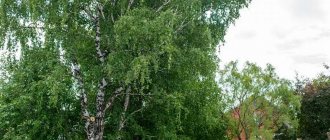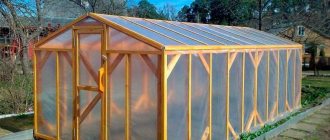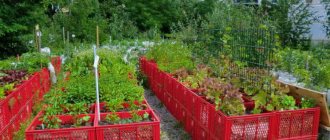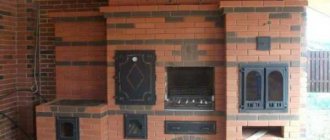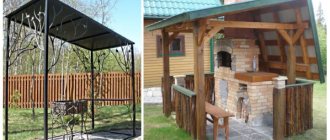Gardeners' interest in smart beds is growing, and the level of discussion and debate is getting hotter. We decided to clarify a little and figure out what must be used to fill a high bed, what is desirable, and what should never be put in it. Join us!
First, let’s remember what high beds are and why they are good.
High (as well as warm, or smart) is a bed in a box filled with organic waste, plant debris and fallen leaves, which during the decomposition process release heat and warm the ground. Thanks to proper filling, garden crops in such a bed can more easily withstand temperature changes, develop better and produce a higher yield.
The organic matter filling the bed not only warms the soil for plants, but over time itself turns into valuable nutritious vermicompost. This means it makes smart beds even more effective.
Advantages and disadvantages of raised beds
A raised bed, made according to all the rules, will become a real lifesaver for many amateur gardeners. Initially, arranging beds above the soil surface requires some costs (mostly physical, since for the walls material that is available at the dacha can be used: boards, pieces of slate, blocks, slabs), but the result is definitely worth it.
Pros of raised beds:
- raised beds at the dacha once made do not have to be dug up every year, they retain their shape;
- weeds appear less often on raised plantings, their distribution area is smaller and, accordingly, it is easier to fight them;
- You can allocate any place you like on the site for harvest, it does not necessarily have to be a vegetable garden;
- raised beds save plantings from waterlogging when groundwater is close to them;
- beds raised above the ground warm up better and the crop ripens faster;
- the borders of the plantings are limited by the frame for high beds, so the row spacing can be decorated with decorative elements, turning them into comfortable and beautiful paths;
- an additional drainage layer laid at the bottom of the bed ensures the correct mode of moistening and aeration;
- additional insulation can be provided for the garden bed;
- disassembled frame beds do not leave traces, so they can be easily disposed of if necessary.
Cons of raised beds
High beds in the garden also have their disadvantages, which you also need to remember:
- since the bed is high, the soil temperature on it is higher than usual (by about 100C), so the moisture evaporates faster and in hot weather additional watering and control of the moisture of the top layer are required;
- durable beds sooner or later develop a resource, the land on them is depleted, the harvest becomes worse, so you need to take care of timely feeding and renewal of the fertile soil layer;
- in high warm beds, rich in humus and limited by a frame, mole crickets often appear, the fight against which takes a lot of effort.
Options for raised beds: pros and cons
There are several ways to make a raised bed. Choose the one that is more convenient, clearer and easier to implement.
American warm bed
Additional “heating”, which is provided by the high planting, created using American technology, allows you to harvest earlier. The American warm garden bed gives vegetables the opportunity to ripen in regions with short summers.
However, it requires a large amount of fertile soil to fill. It is worth taking care of preparing compost in advance.
- A frame is made from a suitable material at the selected location. The width of the bed is 1-1.2 m.
- A fine metal mesh is placed on the bottom to protect against rodents.
- The second layer is sawdust, scraps of paper, cardboard, chopped branches. This layer provides drainage and, gradually overheating, releases heat.
- The third layer is compost, it needs to be well moistened.
- The top layer is fertile soil.
The total height of the raised beds is at least 15 cm.
Barrel
The barrel is the optimal bed for short climbing plants: it takes up little space and looks very aesthetically pleasing.
To organize a garden bed, you need a plastic barrel with a volume of 150-200 liters and fertile soil suitable for growing plants.
- You need to make holes in the side walls along the entire perimeter (in a checkerboard pattern, leaving enough space between them).
- Place a log in the center of the barrel. Cover the remaining space with fertile soil and compact it well.
- While rocking, pull out the log and pour crushed stone or pebbles into the resulting cavity (this is a drainage layer that ensures uniform distribution of moisture during watering).
- Plant the seedlings in the holes made, deepening them to the required depth.
Pyramid
A multi-layered bed - a pyramid - resembles a children's toy of the same name: each “floor” is smaller in area than the previous one.
To ensure uniform watering, a metal or plastic pipe with holes drilled in it is buried in the soil along the entire perimeter.
Arranging beds in this way is ideal for growing greens and strawberries (garden strawberries).
Wheel
If the farm has an unnecessary cart wheel (a rarity by today’s standards, but thrifty owners can’t find anything like that), you can make a raised bed in it with your own hands.
It will turn out to be not only useful, but also decorative, and will become a real decoration of the site. Since the sectors between the spokes are relatively small, it is convenient to grow spices in such a bed.
It is enough to pour a layer of fertile soil and bury the wheel.
Keyhole
An African flavor will be given to the garden by the unusual planting “Keyhole” - a circle in which on one side there is a recess in the shape of a wedge or a semicircle (it allows you to approach the basket with compost).
Setting up a high bed:
- the height of the bed allows you to work while standing, which protects your back and legs;
- bed diameter – 2 m or slightly more;
- A fine mesh basket filled with compost is placed in the center of the bed. As it is used, the compost is renewed through the use of mowed grass and organic residues. In Africa, the climate allows you not to cover the basket; in the middle zone it is better to take care of the lid so that the rains do not wash out the fertilizing ahead of time;
- around the basket the space is filled in layers: drainage (stones), a layer of mulch (branches, paper scraps, cardboard), manure, wood ash, grass clippings and straw, leaves, a layer of soil. Then repeat in the same order, ending with a layer of fertile soil. Each layer needs to be watered well.
Brick
Brick beds can be classified as stationary buildings, since their organization requires a foundation, but the plants are protected from weeds, pests, and moles.
To make high beds, a box of the chosen shape is laid out of brick, which is filled with fertile soil, after which the plants are planted.
Dimensions
There are no strict recommendations on this matter, and there cannot be: the conditions in the country are very different, and so are the people. There are sizes that many consider optimal.
On one site there are very high beds and not very...
So, the dimensions of the raised beds are:
- Height - from 20 cm to 50-60 cm. Look here what a difficult task it turns out to be. The higher the bed is raised, the easier it is to process - less bending. But more land and all the other “fillings” will be required. One more point: if a small bed may be covered with snow and will be covered from severe frosts, then a tall one will freeze through: the sides will also be open. For those beds where annuals are sown, this does not play any role, but for perennial strawberries, let’s say, this is a problem. Therefore, the height is chosen based on these considerations. According to the experience of many summer residents, the optimal height for strawberries is 20 cm. Then you can hope that it will not freeze.
- Width - from 60 cm to 1.2 m. Choose a distance so that it is convenient for you to cultivate the bed. A distance of 60-70 cm is chosen if the approach to the bed is only from one side. If you can reach it from both sides, you can make it a meter or more. It is important that the middle is processed without much stress.
- Length. Here everyone chooses based on the configuration of the site or their desire. There are no recommendations at all.
To prevent the bed from being too high, part of it can be buried: bury it 20-30 cm, and then put walls on top. The removed soil will be used for backfilling (there is often simply not enough soil), and the substrate from the lower coarse layers can be made thicker. And to minimize the cost of maintaining such a bed, you can use drip irrigation.
Material for raised beds: advantages and disadvantages
The material for fencing high beds can be different: wood, concrete, plastic, metal profiles, slate, stone, wood slabs, straw, vines.
Tree
High beds with wooden fencing can be made from boards, timber and slabs.
A bed made of timber looks neat and very aesthetically pleasing, but its organization will be more expensive than one made from boards (unedged) or slabs. The thickness of the board is at least 2 cm, otherwise the box will not withstand the pressure of the soil and will lose its shape (or even break).
Raised beds made from boards are convenient, environmentally friendly, and durable. Even a person who is far from working with wood can make garden beds in his dacha with his own hands.
Wooden beds, as the wood rots, will receive additional fertilizing. A box made of boards, put together by yourself, is the most budget-friendly option for a raised bed.
Concrete
High beds made of concrete are the best option, combining practicality and aesthetics. Concrete blocks protect against weeds, facilitate watering and fertilizing, last a very long time, but require material and physical costs, as well as the ability to work with materials.
Plastic
If you choose plastic, it is better to make a box from corrugated sheets, polycarbonate, or plexiglass. Plastic barrels and large diameter pipes available at the dacha are used.
Unlike brick beds, plastic beds do not absorb water, which reduces the amount of watering; plastic is durable, resistant to rotting and corrosion, lightweight and beautiful. From it you can create decorative elements that will decorate the site. The only drawback is fragility in severe frosts, but for this period, high beds can be covered with non-woven material or spruce branches.
Wicker raised beds
Fences made of vines or branches intertwined become a decorative element and can decorate any landscape. Thanks to the flexibility of the source materials, the bed can be given the desired shape, making it look like a flower bed.
It’s a pity that this beauty is short-lived and the wicker will have to be updated every 2-3 seasons to make the structure look neat.
Metal profile
Beds made from corrugated sheets or corrugated sheets are durable and practical; a variety of sizes and shapes allows you to create a high bed of the desired shape.
The metal profile is protected from corrosion and is not afraid of pests and rodents. Colored profiled sheeting is a real godsend for gardeners and vegetable gardeners; moreover, it is relatively easy to work with. The only downside is the price the beds will cost.
Slate
A frame made from flat or corrugated slate will be strong, practical, durable, easy to handle and inexpensive. Slate is chemically neutral, harmless to soil and plantings, and reliably protects them from weeds and pests.
But when choosing slate, the advantages of which have already been listed, you need to remember that in hot weather it gets very hot, so the beds need frequent watering.
Stone
To organize raised beds, decorative stone is used, which is not only durable, practical, but also beautiful; it will add a special flavor to the summer cottage.
However, working with stone requires professional skills. The material is expensive; a foundation needs to be poured under it and formwork made. This means that the beds will forever remain in the place where they were made.
Cinder blocks
The cinder block frame is easy to assemble and disassemble, without requiring special skills. Just as with the brick option, the durability of the structure is an advantage. In addition, it is quite stable without pouring a foundation.
The inconvenience lies in the large weight of each block.
DPK
Wood-polymer composite is more durable, easier to use and more beautiful than edged boards. The sheets attach to each other without any problems. The fence is not afraid of insects, mold, and bad weather, but it is not cheap.
DSP
Cement particle boards are a modern, environmentally friendly material that is resistant to adverse environmental conditions. It is strong, beautiful and durable. But making beds from it will cost a pretty penny.
Straw
The arrangement of a vegetable garden in an authentic rustic style is consistent with the organization of beds in straw bales.
Straw bales are moistened, fertilized, a layer of soil is poured on top, and then plants are planted. It is short-lived, but very useful for planting, because straw turns into fertilizer over time.
Available materials
You can make a garden bed or box with your own hands from almost any available material. For example,
- plastic bottles,
- old furniture,
- mesh in two layers, the space between which is filled with pebbles,
- logs and other things.
Use your imagination, you can use anything!
Galvanized metal beds
Their absolute advantage over wood is the lack of maintenance. Such beds can be easily assembled even by a fragile woman, will not corrode and will serve, according to the manufacturer, for almost 30 years. The standard version has 5 available colors: yellow, green, brown, blue and unpainted steel. If desired, you can repaint them yourself in any color using metal paints.
The disadvantages again include the rather high price, fixed shape and height. If you decide to save money and not buy a ready-made option, but do everything yourself, then your skills in working with iron will come in handy when cutting sheets and installing.
How to make raised beds with your own hands: step-by-step instructions
To make raised beds with your own hands from scratch, step-by-step instructions are provided. The dimensions of raised beds, material (be it cement, wood or particle boards) and appearance may vary, but the same design principle is suitable for absolutely all beds.
Choosing a place for beds
Bulk beds are good because they can be located in any chosen location. It is only important that the plants have enough sunlight (if they are photophilous) or, on the contrary, they are shaded (if direct sunlight is contraindicated).
Small unevenness in the terrain can be smoothed out using the bottom layer - the mesh. Since raised beds are often also decorative, the location should blend into the overall design of the landscape.
Optimal sizes of raised beds
We make high beds so that they are comfortable to work on. This means that the height of the substrate should be such that you do not have to bend over.
Raised beds, dimensions:
- width 90-120 cm, so that plants can be planted in two rows and it is convenient to approach each one;
- layer height – from 15 to 70 cm.
Otherwise, the dimensions depend on the capabilities and desires of the owner of the site.
Layers of raised beds
How to make raised beds:
- A metal mesh that will protect against rodents that like to dig in the soil. Fine mesh can be replaced with thick cardboard or spunbond, but the mesh is much more functional.
- Branches, sawn timber, paper, which will not only act as a drainage layer, but also, when rotting, supply substances beneficial to plants into the soil.
- Shredded bark, sawdust, straw, grass clippings, corn stalks.
- Paper, thin cardboard or burlap.
- Mown grass, leaves, sawdust.
- Wood ash, compost.
- Sod land.
- Fertile soil.
If you think about it, you can find alternative options for how to fill the beds, but you need to try to stick to the basic principles.
Asbestos cement strips for edging beds
This is the option that I ultimately chose. Manufacturers offer ready-made beds from this material in rectangular and round shapes, but you can make almost any design with corners. The advantages of asbestos cement include a very low price compared to other options while maintaining the aesthetics and durability of the material. Asbestos cement sheets are not subject to corrosion, rotting, are fireproof and can be painted. The cutting of the sheet can also be any and will depend on the agreement with the manufacturer.
According to the manufacturer, the frost resistance of such a fence is 25 winters. The sheets are light enough, so the design is mobile and assembly is accessible to women and teenagers. You can also make paths between the rows from the same sheets.
The only disadvantages include the fact that due to the negative impact of asbestos-cement dust on humans when inhaled and the fragility of the sheet under directed influence, cutting into strips of the required width and height should be carried out in production, and ready-made sides of the future bed should be delivered to the site. Practice has also shown that if you buy a ready-made set of sheets and fasteners, then the four connecting profiles included in the standard package for beds 2 m long and six for beds over 3 m long are not enough. you need to further strengthen the structure with metal or wooden stakes in the middle of each sheet.
Proper arrangement of high beds
The device begins with the preparation of the selected area. The level of fertile soil will have to be raised. Therefore, you need to approach the location from the point of view of convenience, first of all.
Site preparation
The selected area must be cleared of snags, the soil must be dug up and weeds must be selected. Then relatively level the soil level so that the frame becomes level.
Otherwise, when choosing a location, just like in a garden, you need to focus on lighting, absence of drafts and proximity to other plants.
Assembling a frame for a high bed
The height of the frame depends on the height of the bed (it, as a rule, rises above the soil level). Depending on the material, you can install the frame yourself or resort to professional help. The main thing is that the parts of the frame are securely connected to each other.
Installation of the structure
The structure is installed in advance so that the layers with which the frame will be filled have time to compact. Heavy structures (concrete, stone) are installed on the foundation.
Filling the bed
It is best to fill a bed that will be sown in the spring in the fall, but if this is not possible, work should begin in early spring, at least a month before planting.
Concrete beds
Another monumental option: this design is strong and reliable, can be of any shape and height and, if necessary, will take on the role of a supporting wall if the site is on a slope. Concrete can be painted or lined with stone. but an ideal site must be prepared for such a frame, since durability will depend on compliance with the technology when pouring. the solution will harden for a long time, and if you can plant the first plants in a galvanized bed almost on the same day, then it can take up to a week for the concrete structure to completely dry.
I would recommend using this material only if the site planning was done together with a landscape designer and you are sure that you do not want to change the location for the garden in the next 30 years.
When is the best time to do it and what to plant?
Bulk beds need to be made in advance, preferably in the fall, so that the layers have time to cake, compress and each perform its function.
The raised soil layer warms up better, so you can plant any crops.
Plant rotation
The first year, with proper organization, promises a good harvest, so you can plant cucumbers, tomatoes, sweet peppers, zucchini, pumpkins, cabbage and other vegetable crops. Next year it is recommended to sow the beds with greens and herbs. And after another year, renew the top fertile layer and plant vegetables again.
High bed for strawberries
Strawberries have a root system located in the top layer of soil, so the fertile layer can be made small (15 cm). Cover the top of the bed with a dark film, make holes in it and plant strawberries. It is recommended to cover the plantings with spruce branches for the winter.
High bed for cucumbers and tomatoes
The principle of organization is the same as in other cases, but in the corners or on the side walls of the frame you need to attach bars and pull wire (string) to support the tendrils and creeping sprouts.
Using spandbond (agrofilm) for beds
Agrofilm is used as a covering material, stretched over arcs to prevent contact with plants. During watering, the film is removed.
Spandbond is more convenient and durable than polyethylene, its service life is 5-7 years.
Caring for raised beds
Caring for it is not much different from caring for a garden. The soil needs to be watered and mulched, weeded, and weeds must not be allowed to appear.
After two or three years, you need to renew the fertile layer in the fall, apply fertilizer, and inspect the frame material for integrity.
Well, that’s probably all we have collected on this topic. Whether you need raised beds is up to you to decide. How to make them and what material to use for the frame can be seen in the selection of photos.
Harvest multiple times
Harvest ripe fruits as often as possible without allowing them to become overripe. Beans, cucumbers, and peppers will stop bearing fruit if you do not rid them of ripened fruits in time. As for salads, they can be periodically thinned to extend the period of green mass growth.
With the right approach, you can harvest two crops from high beds
Do not plant all plants at the same time. This will extend the harvest period. For example, plant beans 1 row every 2 weeks and harvest as they ripen. After the final harvest, to prepare the bed for the next season, you need to cover it with mulch or compost.
